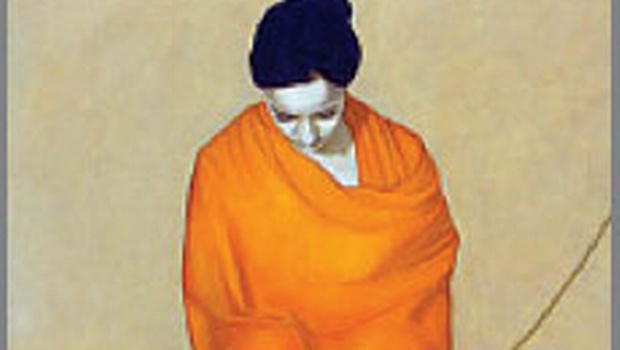Artist C F John has always been reticent with words. His works are also imbued with a special kind of wordless resonance. They communicate but not in a common language. They reach out to the wordless space within us all. That space of calm, cohesion and harmony when we simplify and declutter our thoughts. In his work, there is no confusion but distillation. No impulses but a balance between the tangible and the invisible. His protagonists are introspective. Meditative. They don’t say, “here I am!” They state, ”I am. And it’s enough.”
He once said,”I define myself in a state of connectedness, a sort of readiness for dissolution of the self in timelessness. Art is meditation and a prayer for me.” It shows.
It helps that he lives and works far from the city. In his cosy home, you will find a sense of containment and contentment.
He agrees that be it life or art, he likes to eliminate the inessentials that stand in the way of feeling life deeply. Even his colours, he says, “ are eased gently into the canvas without obvious articulation. The images are minimalistic and backgrounds becalming. I always strive to achieve balance of the physical and emotional planes, geometrical lines and shapes. Stillness is a dynamic thing for me. Everything comes from stillness and returns back into it.”
His house reflects his love for nature. He took two years off once to just wrap himself in agriculture and to learn about bio-diversity, water harvesting etc.
He recalls, “It was also a voyage of exploration into myself. What we see in the land is also nurtured (or betrayed) within.”
Working with land was similar in a way to working on canvas though the work on land is short-lived and yet in a way eternal.
In CF John’s works, you can see the culmination of a long period of seeding the mind, harvesting the fruits of silence and just being in the moment. An interview..
What have you been doing recently?
Earth and life has been central to my thinking always. The art event that I worked along with Tripura Kashyap and Azis TM in and around a dried open well in 2003 pushed me further to explore the deeper connection with soil and life. Till then earth and life were abstract ideas.
I felt suddenly the need for a direct connection. Keeping this in mind, I started engaging with the community around my own studio at Byraveshwara Layout near Hennur Bande. This meant, I had to be involved practically in most matters that a local community needs to care about.
Along with it, we were also able to plant many tree saplings which now are attracting many birds to our layout. Our streets today are known by the names of trees.
Apart from that, along with Murali Cheerot and Azis TM, I have been working with children from all the schools of one panchayat. This has been in the area of creative learning.
The programme is called culture – agriculture. It aims to nurture creativity among children and establish their own personal connection with earth and community. Doing paintings in between these engagements has allowed me to breathe differently.
Does an artist need to leave his isolation to work with communities?
I suppose it has to be the call of the individual. At the same time I personally feel, churning works from the head and even from hearts alone is not enough today. It is time to make bodily connections, with earth and life. That alone can heal.
You have always been very protective of personal space and your sense of isolation..there has never been visible marketing, do you think, it has helped the artist and the human being in you to thrive?
Yes, by nature I desire silence and isolation. Engagement with the communities has helped me to get a glimpse of the core of silence, like entering the eye of the storm that is stillness.
I do not like to play a well ruled game. The whistle blower, player and the audience all are so pre-determined. I would like to join a sport / leela in which people would not know when to give an applause.
What disturbs you most about Bangalore and reassures you as well?
Bangalore will never sleep. It has always found its ways, with much internal churnings. it will find its way in the future too.
Reema Moudgil works for The New Indian Express, Bangalore, is the author of Perfect Eight, the editor of Chicken Soup for the Soul-Indian Women, an artist, a former RJ and a mother. She dreams of a cottage of her own that opens to a garden and where she can write more books, paint, listen to music and just be.








 with
with